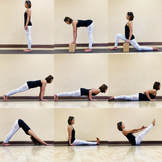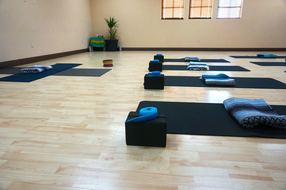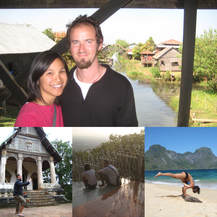 When the mind doesn’t know what to expect, change can be challenging. When the mind has an experience to draw from, change can be managed. Newcomers to a practice in the movement arts may be surprised by the difficulty in a simple pose or movement. They may feel a bit awkward and unable to maintain stability. A few students may push past their ability to just “suffer” through a “final” pose. Some students may not understand what they are feeling and not be able to articulate what they are experiencing. I find all of these behaviors normal and part of the learning process.
A first attempt at something new and unfamiliar can be challenging, and when we are surrounded by people who look “perfect” in their poses, it’s easy to make assumptions and comparisons. Being visual creatures, we try to mirror what we see and if we don’t get it right away, it can be frustrating as we tend to focus on what we cannot do as opposed to what we can. “What am I doing wrong?” “Ugh, I can’t do that! There’s no way!” “When will I be able to do (name of pose or movement)?” “I want to look like (student’s name).” Advancement does not come with a pose; it comes with developing self-awareness. Time, practice, frequency, and quality of practice are major factors in one’s progression. However, if a student demonstrates increasing strength and flexibility to achieve challenging postures, is an advanced posture an indicator of an advanced practice? In regards to physical ability, to a certain degree, yes. In regards to a practice as a whole, no, not necessarily. I often tell my students that practice does not become easier with time, it should become more challenging. The more we understand the subtleties of a posture or movement, regardless of level of difficulty, and the more we can integrate what we understand, the more challenging the practice. Aesthetically, a pose may be accessible and look very good from the outside, but ease of breath, calm and clarity of mind, feelings of control and balance, making sure in the long run we are doing more good than harm, and how that affects our mind, body, behavior in and outside of class, are also part of the practice. Patience for practice, noticing our ever-changing needs for practice, and the ability to adapt and modify to maintain integrity of our practice are skills we don’t explicitly focus on in class. However, these skills that indicate the developing qualities of self-awareness, are, as a teacher, what I look for within students to see how they are progressing. I, as a teacher, am effective only to certain extent to influence, improve, and progress your practice. My role as a teacher is to create sequences to build upon my students’ strengths to address their weaknesses, to slow students down, to increase awareness in the body, mind, and breath. I make adjustments, suggest modifications, encourage, correct, and erase any preconceived definitions of perfection. However, I will ultimately never know a student, their mind and body, better than they know themselves. One of the greatest feelings I have ever had as a teacher is looking up and seeing that every single student looks wonderfully, beautifully different, yet similar, in their pose. In other words, each student has been able to make good judgment on an appropriate alignment and modification that their bodies need on that particular day, at that particular moment. All understand the guiding principles of practice to uphold the integrity of their posture. All of their faces are calm, their breath, smooth and even, and their eyes focused forward. The only comparisons they choose to make are between truthful observations of the self, and not of others. And that to me is progress.
3 Comments
Put simply, it was hard. The images projected by media did not match up with how I saw myself. Magazines and Hollywood portrayed yoga with very lean female yogis demonstrating gymnastic or dancer-like abilities. I could not imagine my broader, more athletic frame being able to achieve those kinds of postures. In other words, whatever I associated with yoga, I found very intimidating and inaccessible. I was young, perhaps not as self-assured. So with all the excuses in the world and very little understanding of the practice, I wrote yoga off as something not for me.
Growing up I played soccer. I found confidence, a need for movement, and a love for training that required discipline and respect. Once I graduated high school, I always found myself chasing after the same methodology of movement I found in competitive sports. Nothing matched the hard work, camaraderie, and lessons I gained from soccer. Throughout my 20s and 30s, I competed in co-ed adult soccer leagues. There were no daily practices, just once-a-week 90-minute games. Injuries were inevitable without training and practice. On game days, I noticed I was surrounded by adults, many of us trying to recapture our glory days of soccer, physically ailing with wrapped up ankles and knees. Then I sprained my right ankle two summers in a row, the second sprain putting me in crutches for two weeks and rehabilitation for several months. Never before had I hurt myself this badly from soccer. Many of my teammates empathized, but said it was common and I would learn to deal with it. That was unacceptable to me. So I stopped playing and I focused my efforts at the gym. Lifting weights and doing cardio on stationary machines made me feel strong and in shape, but I became stiff and lost mobility in my shoulders and hips. Movement, training, and discipline felt different. I needed something, something I could grow old with, something, I realize retrospectively, that would impact me not just physically, but mentally, emotionally, and spiritually. While living in Beijing from 2007 to 2015, any preconceived notions I had of yoga seemed to disappear as I was no longer inundated with ideas projected by media. I entered my first yoga class with a clean slate. I was older, more confident, more comfortable in my own skin, and had a particular intention in mind. That is, let’s try something new! I had no expectations for myself except to try, to learn, and to explore. I didn’t care that I couldn’t achieve many of the postures. Rather than think yoga was hard, my mindset was more curious and fascinated by questions of why and how. Why is it difficult to hold a high lunge for five breaths? Why can’t I breathe easily here? Why are my shoulders fatiguing in downward facing dog? How is it that I am so strong but cannot do these “simple” movements or postures? How can I begin to improve? I found the mental and physical challenges of practicing yoga reigniting the discipline I knew I had inside of me. I loved how hard it was and I was open to trying any part of the practice, any of the postures, any of the modifications, any of the props that would help open, support, engage, relax, and improve my practice. I found teachers I respected. I watched. I listened. I read. I chanted. I breathed. I tried over and over again. I was excited to learn. I began to understand things about myself that I wasn’t even aware of before. And overall, I just felt so good inside and out. Yoga practice across the years, the breakthroughs, the setbacks, the plateaus, the intensity, the relaxation, and the people who have taught me, with whom I have practiced, and whom I have taught, were all teaching me invaluable lessons. With the constant change of the self and the adaptability of yoga practice, I knew I had found something I could grow old with, where no limitations were limiting enough, and where there was no endpoint to my progression and learning. I have always said that progression will beat perfection in its sustainability, wisdom, and state of mind. And that is exactly what I have found through yoga. People that know me well know that Kung Fu is very important to me. It has been a large part of my life for almost 20 years and I would not be who I am today without it. But, for those on the outside, who maybe think it is just a bunch of kicking and punching, what is it about this art that makes it so unique and valuable as a tool for self development? What does this traditional practice have to offer us to help us deal with our modern world? Kung Fu is not just a martial art, it is a holistic tool for self-development. It teaches us self-control, confidence, humility, self-reflection, and provides us with a healthier body and mind.
Kung Fu is a ‘peace-time’ martial art. The chinese character for martial art, ‘wu’ (武), when broken down into its parts actually means ‘to prevent violence’. We train to have control over our responses and not allow aggression to dictate our actions. This is in stark contrast to the predominant physical culture in the west. It is very common during sports for coaches and players to say things like, “get angry”, “kick their ass”, “kill ’em”, to trigger a response in their players and teammates. I grew up playing western sports and progressed to a high level and I can remember the highs and lows this type of environment created. I learned a lot, but I never understood the need for such triggers. I performed better when I was calm and focused, but I was not given the tools to find that state. I had to figure it out on my own. In Kung Fu we learn a different way. We learn to react to aggression and stress with a calm and focused response. We train to challenge ourselves, not others. One of the most common sayings in China when you talk to martial artists is “ xi wu, hui you”. This translates to “through martial arts, friendship”. Kung Fu brings people together. Some of my closest friends have come through training kung fu. People from incredibly diverse backgrounds, but the common ground of training and loving martial arts created bonds that last. In Kung Fu demographics don’t matter. Just your willingness to train and learn. In kung fu we focus on cooperation over competition. It does not matter who is better, because we are all there for the same reason, working towards the same goal. Our first responsibility in class is to help your classmates improve. This creates an inclusive environment without fear of judgement. There might be students of different abilities, ages, but everyone is on the same path, and it is the responsibility of those ahead to help those behind. When you start training kung fu it is a path that never ends. There is always more to learn, like a musician who spends a lifetime mastering an instrument. However, in this case the instrument is your body. As it evolves and changes we learn to adapt and new lessons are presented to us. We don’t graduate from kung fu, or fail to make the team. Whether you begin classes when you are 12, 25, 40, or 70 you have a lifetime of lessons ahead of you. When I began kung fu I had no idea how much potential it had to create positive change in people’s lives. I feel very humbled to be able to share my experience with others and give them the same opportunities that have been so impactful in my life.  We are a school, not a studio. The distinction may seem small, but to us it captures the essence of what we are trying to accomplish and share with our students. Regardless of what class you are in, tai ji, yoga, or kung fu, we look at you as our students, not clients. In a school, you are there to learn, to grow, and to strive toward your goals. We create bonds with our students and try to learn what they need to progress. We are not only thinking about that one class or workout. We are looking at the bigger picture. Not only where you are today, but where we can help you be in 3 months, 6 months, or a year from now. We have both been in education and teaching for many years and it was natural for us to apply the same logic, care, and dedication to the mind body arts as we did in the classroom. We have always been deeply committed to our practice and have experienced the benefits first hand. In our own development, we both have had influential teachers that have given us the support we needed to be where we are now in our practice. This is the main reason why only the two of us teach classes at the school. We are very mindful of the instruction we give our students and the integrity of what we offer and hold ourselves to a very high standard. One of the greatest joys we have had since opening Sequoia Kung Fu & Yoga is seeing the progress of our students. We often comment to one another on how far people have come, especially those who have been with us for awhile now. It is common for Maya and I to chat about how different people are doing. We get excited to share with each other when we see someone make a breakthrough. We also use each other as a resource to improve our understanding and teaching methods. So in short, yes, we do talk about you;) So like a school, Sequoia Kung Fu & Yoga is a place for learning, exploration, discovery, play, and experimentation. We set up our environment to enhance our students learning and to foster curiosity, kindness, and constant growth. We constructively critique and evaluate ourselves to adjust our teaching and lesson plans to fit the needs of our students. We believe all are capable of practice and want to make learning accessible to everyone.  My teacher would often say that it was his job to fill my cup. He told me that in the beginning, you start off with a small cup. It is easy to get overwhelmed and lost in what you are learning because it is so new. You may feel that it is too much to learn or that you will never understand. However, over time your cup gets bigger and you understand a little more as your knowledge grows deeper and deeper. The analogy was comforting, but I thought for a long time about one simple question, how do I get that bigger cup? The answer is patience, consistency, and mindfulness. You need patience to allow the time needed for significant change to take place. Patience with yourself to not give up or get frustrated when you don’t know how to do something or when you feel overwhelmed. Patience with the process, to slow down and enjoy it. You need consistent practice for change to happen. Make yourself and your well-being a priority. Be consistent in what you practice. The greatest improvements come from the repetition of your core practice. And maybe most importantly, be mindful in what you do. Don’t turn off your brain, don’t distract yourself in your practice. Be present and think. Pay attention to your body and what it is telling you. Listen to your teachers and try to apply what they tell you to your own practice. By being mindful, you add depth to everything that you do. As teachers, we are on the same journey as you, but it is also our job to help you fill your cup. We are continually working to deepen our practice and understanding so that we can keep our own well of knowledge alive and evolving. We share it with our students openly and as we get to know them and their needs better, we can give them the support that they need to fill their cup.  Opening a school started off as a daydream, molded by conversations over coffee while sitting outdoors under an often hazy gray sky in Beijing, China, the place we called home from 2007 to 2015. We would throw about different names for fun, until Sonny came up with Sequoia Kung Fu & Yoga. More ideas took shape and I started to sketch out different possible logos. However, it was all still a daydream we enjoyed during our off-hours. We went about our work week, teaching English by day and practicing our respective disciplines by night. From 5:00PM to 8:00PM, five to six days a week, we dedicated that block of time to martial arts and yoga. Sonny had his teacher and a core group of students who practiced outdoors, regardless of humidity, dropping temperatures, or rain. After several years of training, under his teacher’s supervision, Sonny often took the helm and did most of the direct instruction. I had my teacher and a core group as well. We practiced in my apartment, often fitting as many as eight of us across the living room floor. Eventually my teacher left, and I took over instruction. Five to eight in the evening became a priority and the part of our day we looked forward to most. After eight years abroad, we decided to move back to the States. The daydream of Sequoia Kung Fu & Yoga floated to the forefront, becoming a question: Should we open our own school? The answer seemed clear, yet fuzzy, easy, but difficult, exciting AND scary all at the same time. In the end, fear was not a good enough reason not to try. The biggest step to an unequivocal “yes” was truly believing in ourselves and that we have something special to offer. Our excitement and passion to teach and impact lives drove our steps forward. Born out of the love and need for practice, a simple daydream materialized into the space we have created today. We continue to open our doors to Sequoia Kung Fu & Yoga, welcoming and meeting faces in our community. As an extension of our own learning process, there is a genuine love and desire to teach. We want to cultivate an environment that encourages practice. Building a community of people who all want to feel good, be healthy, and discover something that broadens the mind and impacts our experience, Sequoia Kung Fu & Yoga is a place for all who want to learn and practice. |
Sequoia Kung Fu & YogaCo-Owners & Head Instructors Sonny Mannon and Maya Rodriguez Archives
July 2018
Categories
All
|
 RSS Feed
RSS Feed